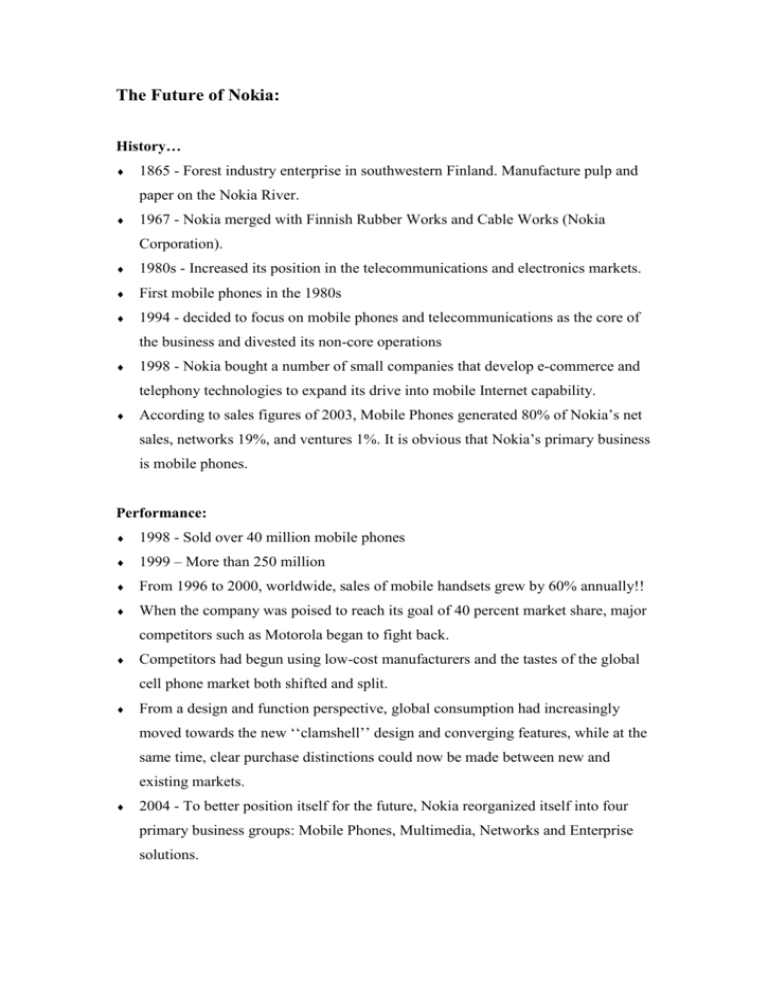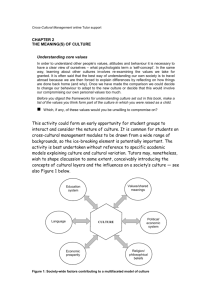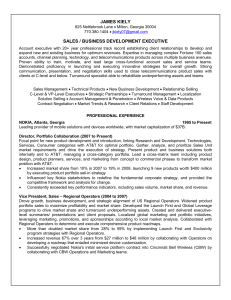The Future of Nokia
advertisement

The Future of Nokia: History… 1865 - Forest industry enterprise in southwestern Finland. Manufacture pulp and paper on the Nokia River. 1967 - Nokia merged with Finnish Rubber Works and Cable Works (Nokia Corporation). 1980s - Increased its position in the telecommunications and electronics markets. First mobile phones in the 1980s 1994 - decided to focus on mobile phones and telecommunications as the core of the business and divested its non-core operations 1998 - Nokia bought a number of small companies that develop e-commerce and telephony technologies to expand its drive into mobile Internet capability. According to sales figures of 2003, Mobile Phones generated 80% of Nokia’s net sales, networks 19%, and ventures 1%. It is obvious that Nokia’s primary business is mobile phones. Performance: 1998 - Sold over 40 million mobile phones 1999 – More than 250 million From 1996 to 2000, worldwide, sales of mobile handsets grew by 60% annually!! When the company was poised to reach its goal of 40 percent market share, major competitors such as Motorola began to fight back. Competitors had begun using low-cost manufacturers and the tastes of the global cell phone market both shifted and split. From a design and function perspective, global consumption had increasingly moved towards the new ‘‘clamshell’’ design and converging features, while at the same time, clear purchase distinctions could now be made between new and existing markets. 2004 - To better position itself for the future, Nokia reorganized itself into four primary business groups: Mobile Phones, Multimedia, Networks and Enterprise solutions. "The Nokia Way" The mission of Nokia is "Connecting People" and the company does this through a program called "The Nokia Way": Values of customer satisfaction, respect, achievement, and renewal. Strategy: 1. Expand mobile voice. 2. Drive consumer multimedia. 3. Bring extended mobility to enterprises. Internal communications: Nokia uses "Nokia People Magazine", "Nokia News Service" – online. For customers: "Nokia Club" - exclusive benefits and priority customer support, and "Nokia Newsletter" worldwide. Environment: working on greener products. Competition: The industry is quite diverse with global players from the United States, Korea, Germany, Japan, and Europe. Pressure from consumers for the latest in technology and features. The main players carry a full range of options to cover most any consumer’s needs. The result is the dominance of the global market by firms: Motorola – 1. 2003 sales were $27.1 billion 2. 38% of its sales come from the personal communications segment. 3. led the way with its clamshell style Samsung – 1. 2003 sales were $36.4 billion. 2. Strong on the manufacturing side - producers of chips for mobile phones. Siemens AG – 1. Focus on electrical engineering 2. 2004 sales were $106,655 billion. Sony Ericsson – 1. This alliance leverages the innovative operations of both firms to produce handsets and offer services. 2. Financial breakdowns regarding markets and products are unavailable. Expansion beyond Europe: Jorma Ollila (CEO) said in 1997, "Until the 1980s, Nokia was Finnish Company, in the 1980s Nokia was a Nordic company, and in the beginning of the 1990s a European company. Now, we are a global company." In 1994, Nokia was the first European manufacturer to begin selling mobile phones in Japan. Approach to different markets: Maintain its central brand elements while still adjusting the execution of its message to match local tastes. Research and development centers in 15 countries. Sells its products in more than 130 countries. Manufacturing plants in 10 countries. Finland - largely a test market for the company. United States - an environment of price competition. Japan - an area of experimentation with cutting-edge products. China, because of low penetration, an area with enormous growth potential. China - a strategic market and important manufacturing base for Nokia. Key issues: Nokia has long dominated the global cellular phone market. 2004 signaled that this trend was not to continue. Several points to the advantage of Motorola and Samsung - clamshell style phone designs. Nokia’s approach matches up with the consumer needs of Developed markets and developing markets. While consumer tastes vary from country to country, major cell phone brands handle this through their extensive lineup of SKUs. The issue has become more or less one of grouping countries by purchase behavior so as to best realize economies of scale in production. Current Business Model: Production takes place in corporate-owned factories located around the world. Up until this point, this has been a competitive advantage. In recent years cell phone technology has been licensed by other competitors to lower-cost manufacturers, many of them in China. In attempts to gain back market share, Nokia has lowered prices on its own models. This will have effect on Nokia’s bottom line. The profits that were Nokia’s competitive advantage will erode away, and they will find themselves in the trenches with every other cell phone manufacturer. They increased the number of new phone designs being introduced in 2004. Among them are several of the clamshell varieties. Market characteristics: Cell phones have become much more than just voice-communication devices. Two separate categories for the markets in which Nokia participates: consumers in developed markets and developing markets. Developed markets: cell phones are accepted as a part of life. High Adoption rate, better models, more features. In developed markets, the focus is on features and customization. This market is difficult to satisfy as they have positioned themselves for largescale production of standardized models. Developing markets: offer great opportunity to cell phone manufactures as the adoption rates among the population is still relatively low but expected to grow dramatically. In India and China, Nokia's market share is 32.6% and 15.6%, respectively. Another issue in developing countries: Lack of a communications infrastructure to support wireless technology. Nokia also has to have an appropriate range of models for its developing markets, as well, keeping in mind, throughout, the need to maintain Nokia’s reputation for quality and stylish design. Manufacturing Complexities: Increasing pressure to manufacture smaller lots of customized and adapted models as well as pressure to lower production costs. The trend for competitors has been to outsource production to low cost factories, many of which are in China. This is compounded by the licensing of cell phone technologies that allow such manufacturers to product handsets under their own brand name. What is Nokia to do? The promise of emerging markets such as China and India loom large, but does Nokia have what it takes to maintain their foothold and manage their costs competitively? For years, the strength of Nokia had been in the ownership of its factories and the expertise of its workers. Would Nokia be able to transfer that knowledge to lowercost manufacturers in time to stay on top? How can Nokia position itself in developing markets to capture future market share (while maintaining economies of scale)? What must Nokia do to better position their mobile phone business in developed markets? Can Nokia maintain economies of scale in the developed markets? Should it use outsourcing as part of its new strategy?



